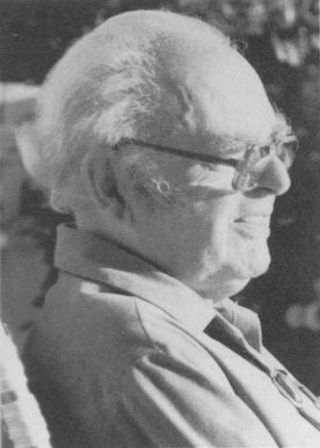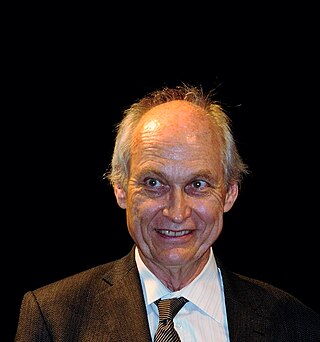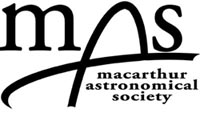Related Research Articles

An astronomer is a scientist in the field of astronomy who focuses their studies on a specific question or field outside the scope of Earth. They observe astronomical objects such as stars, planets, moons, comets and galaxies – in either observational or theoretical astronomy. Examples of topics or fields astronomers study include planetary science, solar astronomy, the origin or evolution of stars, or the formation of galaxies. A related but distinct subject is physical cosmology, which studies the Universe as a whole.

The American Astronomical Society is an American society of professional astronomers and other interested individuals, headquartered in Washington, DC. The primary objective of the AAS is to promote the advancement of astronomy and closely related branches of science, while the secondary purpose includes enhancing astronomy education and providing a political voice for its members through lobbying and grassroots activities. Its current mission is to enhance and share humanity's scientific understanding of the universe as a diverse and inclusive astronomical community.

The Royal Astronomical Society (RAS) is a learned society and charity that encourages and promotes the study of astronomy, solar-system science, geophysics and closely related branches of science. Its headquarters are in Burlington House, on Piccadilly in London. The society has over 4,000 members ("Fellows"), most of them professional researchers or postgraduate students. Around a quarter of Fellows live outside the UK.

Bohdan Paczyński or Bohdan Paczynski was a Polish astronomer notable in the theory of the stellar evolution, accretion discs, and gamma ray bursts.

The Astronomical Society of the Pacific (ASP) is an American scientific and educational organization, founded in San Francisco on February 7, 1889, immediately following the solar eclipse of January 1, 1889. Its name derives from its origins on the Pacific Coast, but today it has members all over the country and the world. It has the legal status of a nonprofit organization.

Bartholomeus Jan "Bart" Bok was a Dutch-American astronomer, teacher, and lecturer. He is best known for his work on the structure and evolution of the Milky Way galaxy, and for the discovery of Bok globules, which are small, densely dark clouds of interstellar gas and dust that can be seen silhouetted against brighter backgrounds. Bok suggested that these globules may be in the process of contracting, before forming into stars.

Donald Lynden-Bell CBE FRS was a British theoretical astrophysicist. He was the first to determine that galaxies contain supermassive black holes at their centres, and that such black holes power quasars. Lynden-Bell was President of the Royal Astronomical Society (1985–1987) and received numerous awards for his work, including the inaugural Kavli Prize for Astrophysics. He worked at the University of Cambridge for his entire career, where he was the first director of its Institute of Astronomy.

Michael S. Turner is an American theoretical cosmologist who coined the term dark energy in 1998. He is the Rauner Distinguished Service Professor Emeritus of Physics at the University of Chicago, having previously served as the Bruce V. & Diana M. Rauner Distinguished Service Professor, and as the assistant director for Mathematical and Physical Sciences for the US National Science Foundation.

Bryan Malcolm Gaensler is an Australian astronomer based at the University of Toronto. He studies magnetars, supernova remnants, and magnetic fields. In 2014, he was appointed as Director of the Dunlap Institute for Astronomy & Astrophysics at the University of Toronto, after James R. Graham's departure. He is currently the co-chair of the Canadian 2020 Long Range Plan Committee with Pauline Barmby.
Lisa Jennifer Kewley is an Australian Astrophysicist and current Director of the Center for Astrophysics | Harvard & Smithsonian. Previously, Kewley was Director of the ARC Centre of Excellence for All Sky Astrophysics in 3-D and ARC Laureate Fellow at the Australian National University College of Physical and Mathematical Sciences, where she was also a Professor. Specialising in galaxy evolution, she won the Annie Jump Cannon Award in Astronomy in 2005 for her studies of oxygen in galaxies, and the Newton Lacy Pierce Prize in Astronomy in 2008. In 2014 she was elected a fellow of the Australian Academy of Science. In 2020 she received the James Craig Watson Medal. In 2021 she was elected as an international member of the National Academy of Sciences. In 2022 she became the first female director of the Center for Astrophysics | Harvard & Smithsonian.
Scott Duncan Tremaine is a Canadian-born astrophysicist. He is a fellow of the Royal Society of London, the Royal Society of Canada and the National Academy of Sciences. Tremaine is widely regarded as one of the world's leading astrophysicists for his contributions to the theory of Solar System and galactic dynamics. Tremaine is the namesake of asteroid 3806 Tremaine. He is credited with coining the name "Kuiper belt".

Kenneth Charles Freeman is an Australian astronomer and astrophysicist who is currently Duffield Professor of Astronomy in the Research School of Astronomy and Astrophysics at the Mount Stromlo Observatory of the Australian National University in Canberra. He was born in Perth, Western Australia in 1940, studied mathematics and physics at the University of Western Australia, and graduated with first class honours in applied mathematics in 1962. He then went to Cambridge University for postgraduate work in theoretical astrophysics with Leon Mestel and Donald Lynden-Bell, and completed his doctorate in 1965. Following a postdoctoral appointment at the University of Texas with Gérard de Vaucouleurs, and a research fellowship at Trinity College, Cambridge, he returned to Australia in 1967 as a Queen Elizabeth Fellow at Mount Stromlo. Apart from a year in the Kapteyn Institute in Groningen in 1976 and some occasional absences overseas, he has been at Mount Stromlo ever since.

Sutherland Astronomical Society Incorporated (SASI) is an amateur astronomical society based in the Sutherland Shire, in the southern suburbs of Sydney, Australia. It operates the Green Point Observatory, it is one of the two founding organizations of the National Australian Convention of Amateur Astronomers, and its members have discovered two comets and two novae.

Macarthur Astronomical Society is an organisation of amateur astronomers, based in the Macarthur Region of outer South Western Sydney, New South Wales, Australia.

Anja Cetti Andersen is an astronomer and astrophysicist from Hørsholm, Denmark.

Amanda Elaine Bauer is an American professional astronomer and science communicator. She is the Deputy Director and Head of Science and Education at Yerkes Observatory in Williams Bay, Wisconsin. She was previously based in Tucson, Arizona, working as Head of Education and Public Outreach at the Large Synoptic Survey Telescope. From 2013 to 2016 she was a Research Astronomer at the Australian Astronomical Observatory (AAO). Her principal field of research concerns how galaxies form, how they create new stars, and particularly why they suddenly stop creating new stars.

Vassiliki Kalogera is a Greek astrophysicist. She is a professor at Northwestern University and the Director of the Center for Interdisciplinary Exploration and Research in Astrophysics (CIERA). She is a leading member of the LIGO Collaboration that observed gravitational waves in 2015.
Betty Louise Turtle was an Australian astronomer and physicist. In 1971, with her colleague Paul Murdin, she identified the powerful X-ray source Cygnus X-1 as the first clear candidate for a black hole.

Conny Clara Aerts, born 26 January 1966, is a Belgian (Flemish) professor in astrophysics. She specialises in asteroseismology. She is associated with KU Leuven and Radboud University, where she leads the Chair in the Astroseismology group. In 2012, she became the first woman to be awarded the Francqui Prize in the category of Science & Technology. In 2022, she became the third woman to be awarded the Kavli Prize in Astrophysics for her work in asteroseismology.
Keivan Guadalupe Stassun is an American physicist and astronomer in the field of exoplanets. He is a physics professor at Vanderbilt University and an adjunct professor at Fisk University, institutions at which he oversees and co-directs the Fisk-Vanderbilt Masters-to-Ph.D Bridge Program. Stassun has been an activist promoting the integration of underrepresented groups in the fields of STEM, especially math and science through research, outreach and teaching.
References
- Bibliography
- Frame, Tom; Donald Faulkner (2003). Stromlo: An Australian Observatory. St. Leonards, NSW: Allen & Unwin. ISBN 1-86508-659-2.
- Notes
- ↑ Frame & Faulkner, p. 163
- ↑ "Australian National Institute for Theoretical Astrophysics". The Astronomical Society of Australia Inc. Retrieved 7 June 2010.
- ↑ "ASA Education and Public Outreach". The Astronomical Society of Australia Inc. Archived from the original on 2 October 2009. Retrieved 7 June 2010.
- ↑ "Foundation for the Advancement of Astronomy". The Astronomical Society of Australia Inc. Retrieved 7 June 2010.
- ↑ "ASA Prizes, Awards and Grants". asa.astronomy.org.au. The Astronomical Society of Australia Inc. Archived from the original on 4 September 2014. Retrieved 29 August 2014.